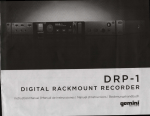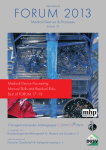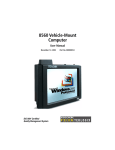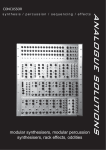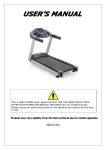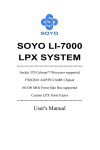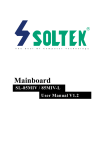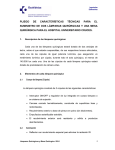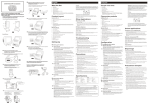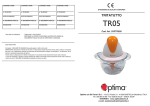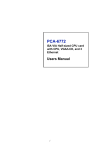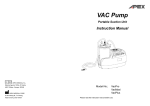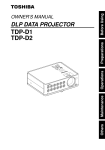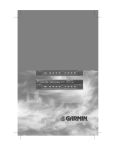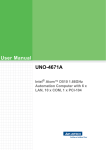Download PPC-103 User`s Manual
Transcript
PPC-103 Celeron®/Pentium®III Panel PC with 10.4" LCD flat panel display User’s Manual Copyright This document is copyrighted 2002 by Advantech Co. Ltd. All rights are reserved. Advantech Co., Ltd. reserves the right to make improvements to the products described in this manual at any time without notice. No part of this manual may be reproduced, copied, translated or transmitted in any form or by any means without the prior written permission of Advantech. Information provided in this manual is intended to be accurate and reliable. However, Advantech assumes no responsibility for its use, nor for any infringements upon the rights of third parties which may result from its use. All brand and product names mentioned herein are trademarks or registered trademarks of their respective holders. Part No. 2002010311, 3rd Edition Printed in Taiwan September 2002 PPC-103 User’s Manual ii FCC Class B This equipment has been tested and found to comply with the limits for a Class B digital device, pursuant to Part 15 of the FCC Rules. These limits are designed to provide reasonable protection against harmful interference when the equipment is operated in a residential environment. This equipment generates, uses and can radiate radio frequency energy. If not installed and used in accordance with this user's manual, it may cause harmful interference to radio communications. Note that even when this equipment is installed and used in accordance with this user's manual, there is still no guarantee that interference will not occur. If this equipment is believed to be causing harmful interference to radio or television reception, this can be determined by turning the equipment on and off. If interference is occurring, the user is encouraged to try to correct the interference by one or more of the following measures: • Reorient or relocate the receiving antenna • Increase the separation between the equipment and the receiver • Connect the equipment to a power outlet on a circuit different from that to which the receiver is connected • Consult the dealer or an experienced radio/TV technician for help Warning! Any changes or modifications made to the equipment which are not expressly approved by the relevant standards authority could void your authority to operate the equipment. iii Safety Instructions 1. Please read these safety instructions carefully. 2. Please keep this User's Manual for later reference. 3. Please disconnect this equipment from any AC outlet before cleaning. Do not use liquid or spray detergents for cleaning. Use a damp cloth. 4. For pluggable equipment, the socket-outlet must be installed near the equipment and must be easily accessible. 5. Please keep this equipment away from humidity. 6. Put this equipment on a reliable surface during installation. Dropping it or letting it fall could cause damage. 7. The openings on the enclosure are for air convection. Protect the equipment from overheating. DO NOT COVER THE OPENINGS. 8. Make sure the voltage of the power source is correct before connecting the equipment to the power outlet. 9. Position the power cord so that people cannot step on it. Do not place anything over the power cord. 10. All cautions and warnings on the equipment should be noted. 11. If the equipment is not used for a long time, disconnect it from the power source to avoid damage by transient overvoltage. 12. Never pour any liquid into an opening. This could cause fire or electrical shock. 13. Never open the equipment. For safety reasons, the equipment should be opened only by qualified service personnel. 14. If one of the following situations arises, get the equipment checked by service personnel: a. The power cord or plug is damaged. b. Liquid has penetrated into the equipment. c. The equipment has been exposed to moisture. d. The equipment does not work well, or you cannot get it to work according to the user's manual. e. The equipment has been dropped and damaged. f. The equipment has obvious signs of breakage. PPC-103 User’s Manual iv 15. DO NOT LEAVE THIS EQUIPMENT IN AN UNCONTROLLED ENVIRONMENT WHERE THE STORAGE TEMPERATURE IS BELOW -20° C (-4° F) OR ABOVE 60° C (140° F). IT MAY DAMAGE THE EQUIPMENT. 16.CAUTION: DANGER OF EXPLOSION IF BATTERY IS INCORRECTLY REPLACED. REPLACE ONLY WITH THE SAME OR EQUIVALENT TYPE RECOMMENDED BY THE MANUFACTURER. DISCARD USED BATTERIES ACCORDING TO THE MANUFACTURER'S INSTRUCTIONS. The sound pressure level at the operator's position according to IEC 7041:1982 is equal to or less than 70 dB(A). DISCLAIMER: This set of instructions is given according to IEC 704-1. Advantech disclaims all responsibility for the accuracy of any statements contained herein. v Wichtige Sicherheishinweise 1. Bitte lesen sie Sich diese Hinweise sorgfaltig durch. 2. Heben Sie diese Anleitung fur den spateren Gebrauch auf. 3. Vor jedem Reinigen ist das Gerat vom Stromnetz zu trennen. Verwenden Sie Keine Flussig-oder Aerosolreiniger. Am besten dient ein angefeuchtetes Tuch zur Reinigung. 4. Die NetzanschluBsteckdose soll nahe dem Gerat angebracht und leicht zuganglich sein. 5. Das Gerat ist vor Feuchtigkeit zu schutzen. 6. Bei der Aufstellung des Gerates ist auf sicheren Stand zu achten. Ein Kippen oder Fallen konnte Verletzungen hervorrufen. 7. Die Beluftungsoffnungen dienen zur Luftzirkulation die das Gerat vor uberhitzung schutzt. Sorgen Sie dafur, daB diese Offnungen nicht abgedeckt werden. 8. Beachten Sie beim AnschluB an das Stromnetz die AnschluBwerte. 9. Verlegen Sie die NetzanschluBleitung so, daB niemand daruber fallen kann. Es sollte auch nichts auf der Leitung abgestellt werden. 10. Alle Hinweise und Warnungen die sich am Geraten befinden sind zu beachten. 11. Wird das Gerat uber einen langeren Zeitraum nicht benutzt, sollten Sie es vom Stromnetz trennen. Somit wird im Falle einer Uberspannung eine Beschadigung vermieden. 12. Durch die Luftungsoffnungen durfen niemals Gegenstande oder Flussigkeiten in das Gerat gelangen. Dies konnte einen Brand bzw. elektrischen Schlag auslosen. 13. Offnen Sie niemals das Gerat. Das Gerat darf aus Grunden der elektrischen Sicherheit nur von authorisiertem Servicepersonal geoffnet werden. 14. Wenn folgende Situationen auftreten ist das Gerat vom Stromnetz zu trennen und von einer qualifizierten Servicestelle zu uberprufen: a - Netzkabel oder Netzstecker sind beschadigt. b - Flussigkeit ist in das Gerat eingedrungen. c - Das Gerat war Feuchtigkeit ausgesetzt. d - Wenn das Gerat nicht der Bedienungsanleitung entsprechend funktioni ert oder Sie mit Hilfe dieser Anleitung keine Verbesserung erzielen. PPC-103 User’s Manual vi e - Das Gerat ist gefallen und/oder das Gehause ist beschadigt. f - Wenn das Gerat deutliche Anzeichen eines Defektes aufweist. 15.VOSICHT: Explisionsgefahr bei unsachgemaben Austausch der Batterie. Ersatz nur durch densellben order einem vom Hersteller empfohlenem ahnlichen Typ. Entsorgung gebrauchter Batterien navh Angaben des Herstellers. Der arbeitsplatzbezogene Schalldruckpegel nach DIN 45 635 Teil 1000 betragt 70 dB(A) oder weiger. DISCLAIMER: This set of instructions is given according to IEC704-1. Advantech disclaims all responsibility for the accuracy of any statements contained herein. vii PPC-103 User’s Manual viii Contents Chapter 1 Introduction ......................................................2 1.1 1.2 1.3 Introduction ....................................................................... 2 Features ............................................................................. 2 LCD Secifications ............................................................. 5 1.4 Dimensions........................................................................ 6 1.5 I/O Arrangement ............................................................... 6 Table 1.1:PPC-103 series LCD specifications................ 5 Figure 1.1:PPC-103 panel PC dimensions...................... 6 Figure 1.2:PPC-103 back panel I/O arrangement and cable connections6 1.6 Cutout (Suggestion)........................................................... 7 1.7 Mounting ........................................................................... 8 Figure 1.3:PPC-103 panel mounting cutout dimensions 7 1.7.1 1.7.2 1.7.3 Chapter Panel Mounting............................................................... 8 Figure 1.4:PPC-103 rear panel mounting brackets......... 8 Desktop stand (optional)................................................. 9 Figure 1.5:Desktop stand (optional) ............................... 9 Wall-mounting (optional) ............................................... 9 Figure 1.6:Wall-mounting (optional)............................ 10 2 Installation ......................................................12 2.1 2.2 General ............................................................................ 12 Removing Rear Panel...................................................... 13 2.3 Installing Options ............................................................ 14 Figure 2.1:Removing the PPC-103's rear panel............ 13 2.3.1 2.3.2 2.3.4 2.4 Installing CPU and heat sink assembly......................... 14 Figure 2.2:Cooling fan w/ heatsink installation............ 15 Figure 2.3:Place CPU push cover over CPU ................ 15 Figure 2.4:Insert screw driver into the hole.................. 16 Figure 2.5:Push CPU in position .................................. 16 Figure 2.6:CPU installation .......................................... 17 Installing a primary 2.5” HDD (internal)...................... 18 Figure 2.7:HDD Assembly ........................................... 18 Figure 2.8:Rubber screwed onto the hard disk ............. 19 Installing an FDD.......................................................... 21 Installing I/O Equipment................................................. 22 2.4.1 2.4.2 2.4.3 2.4.4 2.4.5 Installing secondary HDD/CD-ROM (external)........... 22 Parallel port connection ................................................ 23 PS/2 keyboard and PS/2 mouse .................................... 23 Mic-in, line-out ............................................................ 23 External VGA ............................................................... 24 ix 2.4.6 2.4.7 2.5 Four serial COM ports .................................................. 24 Ethernet......................................................................... 24 Installing Software to the HDD....................................... 24 2.5.1 2.5.2 2.5.3 2.5.4 Method 1: Use the Ethernet .......................................... 24 Method 2: Use an FDD................................................. 25 Method 3: Use the COM or parallel port...................... 25 Method 4: Use a 3.5" HDD or CD-ROM ..................... 25 2.6 Exploded Diagram........................................................... 26 2.7 PCM-9573 and I/O Adapter Replacement ...................... 26 Figure 2.11:PPC-103 exploded diagram....................... 26 Figure 2.12:Installing/removing the PCM-9573........... 27 Figure 2.13:Installing/removing the I/O adapter .......... 28 2.8 AC Power Supply and Cooling Fan Replacement .......... 28 Figure 2.14:Replacing the power supply ...................... 29 Figure 2.15:Replacing the cooling fan.......................... 30 2.9 Installation Procedures .................................................... 30 2.9.1 2.9.2 Chapter Connecting the AC power cord .................................... 30 Installing the DC power insulator with hood................ 30 Figure 2.16:DC Insulator Contact Pins......................... 31 Figure 2.17:DC Male Insulator..................................... 31 Figure 2.18:DC Male Insulator Tray ............................ 32 Figure 2.19:DC Male Insulator Cable Clamp............... 32 Figure 2.20:DC Male Insulator Cap ............................. 33 Figure 2.21:DC Insulator Mating.................................. 33 3 Jumper Settings and Connectors ..................36 3.1 Jumpers and Connectors.................................................. 36 3.1.1 3.1.2 3.1.3 3.1.4 3.1.5 Setting jumpers ............................................................. 36 Jumpers and switch....................................................... 37 Table 3.1:Jumpers and their functions.......................... 37 Locating jumpers and switch ........................................ 37 Figure 3.1:Jumpers on the PPC-103 motherboard........ 37 Connectors .................................................................... 37 Table 3.2:Connectors on the PPC-103 motherboard .... 38 Locating Connectors ..................................................... 38 Figure 3.2:Locating connectors .................................... 38 3.2 CMOS Clear for External RTC (JP7) ............................. 39 3.3 COM-port Interface......................................................... 39 Table 3.3:Clear CMOS / External RTC (JP7) .............. 39 3.3.1 3.3.2 PPC-103 User’s Manual COM2 RS-232/422/485 setting (JP2, JP3, JP4) ........... 39 Table 3.4:COM2 RS-232/422/485 setting (JP2, JP3)... 39 Table 3.5:COM2 RS-232/422/485 setting (JP4)........... 40 Table 3.6:Serial port default settings ............................ 40 COM3 / COM4 pin 9 output type setting (JP5)............ 40 Table 3.7:COM3/COM4 pin 9 setting (JP5)................. 40 x 3.4 VGA Interface ................................................................. 41 3.4.1 3.5 3.5.1 Chapter LCD panel power setting .............................................. 41 Watchdog Timer Configuration ...................................... 41 Watchdog activity selection (JP6) ................................ 41 Table 3.8:Watchdog activity selection (JP6) ................ 41 4 Award BIOS Setup.........................................44 4.1 4.2 Award BIOS Setup.......................................................... 44 CMOS Setup Utility ........................................................ 45 4.3 Standard CMOS Setup .................................................... 46 Figure 4.1:Setup program initial screen........................ 45 4.3.1 4.4 Figure 4.2:CMOS setup screen..................................... 46 Hard disk configurations............................................... 46 BIOS Features Setup ....................................................... 47 Figure 4.3:BIOS features setup screen ......................... 47 Figure 4.4:Chipset features setup screen ...................... 50 4.6 Power Management Setup............................................... 52 4.7 PNP/PCI Configuration Setup......................................... 54 4.8 Load BIOS Defaults ........................................................ 55 4.9 4.10 Load Setup Defaults ........................................................ 55 Integrated Peripherals...................................................... 56 4.11 4.12 Password Setting ............................................................. 57 IDE HDD Auto Detection ............................................... 58 4.13 Save and Exit Setup......................................................... 59 4.14 Exit Without Saving ........................................................ 59 Figure 4.5:Power management setup screen................. 52 Figure 4.6:PNP/PCI configuration setup screen ........... 54 Figure 4.7:Load BIOS defaults screen.......................... 55 Figure 4.8:Integrated peripherals screen....................... 56 Figure 4.9:IDE HDD auto detection screen.................. 58 Figure 4.10:Save and exit setup screen......................... 59 Chapter 5 PCI Bus Ethernet Interface..........................62 5.1 5.2 Introduction ..................................................................... 62 Installation of Ethernet Driver......................................... 62 5.2.1 5.2.2 5.2.3 5.3 Chapter Installation for Windows 95 ......................................... 63 Installation for Windows 98 ......................................... 67 Installation for Windows NT ........................................ 73 Further Information ......................................................... 76 6 PCI SVGA Setup ............................................78 6.1 Introduction ..................................................................... 78 6.1.1 6.1.2 6.1.3 Chipset .......................................................................... 78 Display memory............................................................ 78 Display types................................................................. 78 xi 6.2 Installation of SVGA Driver ........................................... 78 6.2.1 6.2.2 6.2.3 6.2.4 6.3 Chapter Further Information ......................................................... 85 7 Audio Setup.....................................................88 7.1 7.2 Introduction ..................................................................... 88 Installation of Audio Driver ............................................ 88 7.2.1 7.2.2 7.2.3 Chapter Installation for Windows 95 ......................................... 79 Installation for Windows 98 ......................................... 81 Installation for Windows NT ........................................ 82 Installation for Windows 2000 ..................................... 84 Installation for Windows 95/98 .................................. 89 Installation for Windows NT ........................................ 91 Installation for Windows 2000 ..................................... 94 8 Touchscreen ....................................................98 8.1 Introduction ..................................................................... 98 8.1.1 8.1.2 8.1.3 8.2 General information...................................................... 98 General specifications................................................... 98 Environmental specifications........................................ 98 Driver Installation for Resistive Touchscreen................. 99 8.2.1 8.2.2 8.2.3 8.2.4 Installation for Windows 95/98/ME ............................. 99 Installation for Windows NT ...................................... 103 Installation for Windows 2000 ................................... 108 Installation for Windows XP ...................................... 111 Appendix A Programming the Watchdog Timer ...........120 A.1 Programming the Watchdog Timer............................... 120 Appendix B Power supply specifications.........................122 B.1 B.2 B.3 Introduction ................................................................... 122 Input Specifications....................................................... 122 Output Specifications .................................................... 123 B.4 Mechanical Specifications............................................. 123 B.5 B.6 Environmental Specifications ....................................... 124 Features ......................................................................... 124 Table B.1:Load range ................................................. 123 Figure B.1:PPC-103 dimensions diagram .................. 123 Appendix C I\O Pin Assignments.....................................128 C.1 Keyboard connector (CN5-1)........................................ 128 C.2 Mouse connector (CN5-2)............................................. 128 C.3 VGA connector (CN6) .................................................. 129 C.4 COM1 RS-232 serial port (CN1-2)............................... 129 Table C.1:Keyboard connector ................................... 128 Table C.2:Mouse connector........................................ 128 Table C.3:VGA connector (CN2)............................... 129 Table C.4:COM1 RS-232 serial port (CN1-2)............ 129 PPC-103 User’s Manual xii C.5 COM3 RS-232 serial port (CN2-1)............................... 130 C.6 COM4 RS-232 serial port (CN2-2)............................... 130 C.7 COM2............................................................................ 131 C.8 Parallel port connector (CN1-1).................................... 132 Table C.5:COM3 RS-232 serial port .......................... 130 Table C.6:COM4 RS-232 serial port .......................... 130 Table C.7:COM2 ........................................................ 131 Table C.8:Parallel port connector ............................... 132 xiii PPC-103 User’s Manual xiv CHAPTER 1 General Information This chapter gives background information on the PPC-103. Sections include: • Introduction • Specifications • LCD Specifications • Dimensions • I/O Arrangement • Cutout (Suggestion) • Mounting 1 Chapter 1 Chapter 1 Introduction 1.1 Introduction The PPC-103 panel PC is a multimedia Celeron/PentiumR III processorbased industrial computer that is designed to serve as a human machine interface (HMI). It is a PC-based system with 10.4" color TFT, onboard PCI Ethernet, multi-COM port interfaces, and a 16-bit audio controller. This simple, complete, compact and highly integrated multimedia system lets you easily build a panel PC into your applications. By incorporating the PPC-103 into your project, your product development time will be shortened. The PPC-103 is a compact, network-compatible PC with extensive features to control a dedicated system in a wide variety of applications. Common industrial applications include factory automation systems, precision machinery, and production process control. It is also suitable for many nonindustrial applications, including terminal information systems, entertainment management systems, and car park automation systems. Our panel PC is a reliable, cost-effective solution to your application's processing requirements. 1.2 Features General • Dimensions (W x H x D): 342 x 265 x 61.5 mm (13.5"x10.4"x2.4") • Weight : 3.5 kg(7.7 lbs) • Safety: UL/CSA, TUV approved • AC model: Output rating: 60 watts Input voltage: 100~240Vac, 2A 50~60 Hz Output voltage: +5 V @ 5 A, +12 V @ 3 A MTBF: 50,000 hrs. • DC model: Output rating: 75 watts Input voltage: 18 V DC ~ 36 V DC, typical 24 V DC, 4.2A max Output voltage: +5V@8A, +12V @ 2.5A PPC 103 User’s Manual 2 • DC model(Optional): Output rating: 65 watts Input voltage: 9.5 V DC ~ 18 V DC, typical 12 V DC, 6.8A max Output voltage: +5V@7A, +12V @ 2 A • Disk drive housing: Space for one internal 2.5" HDD • Front panel protection: IP65/NEMA 4 compliant Standard PC functions • CPU: Intel Celeron. or Pentium® III (PGA 370 socket) • BIOS: AWARD 256KB Flash BIOS, supports Plug & Play, APM v1.2 • Chipset: Intel 82443BX/82371EB • 2nd level cache: 128 KB on CPU • RAM: Two 144-pin SODIMM sockets accept 16~256MB SDRAM • PCI Bus Master IDE interface: Supports two connectors (one internal, one external extension). Each connector supports two IDE devices on two channels (PIO modes 3/4). BIOS supports IDE CD-ROM boot-up and enable/disable • Floppy disk drive interface: Supports one external FDD (360K/1.2MB/ 720K/1.44MB/2.88 MB) • Parallel port: One parallel port, supports SPP/EPP/ECP parallel mode. • Serial ports: Four serial ports with three RS-232 ports (COM1, 3, and 4), one RS-232/422/485 port (COM2). All ports with 16C550 compatible UARTs. • USB: Supports two UHCI USB • Watchdog timer: 62-level interval from 1 to 62 seconds. Automaticallygenerates system reset or IRQ11 when the system stops due to a program error or EMI. Jumperless selection and software enabled/ disabled. • Battery: 3.6 V @ 600 mA lithium battery • PCI/ISA expansion slot :support either on PCI or one ISA expansion card. Solid State Disk (SSD) • One 50-pin socket: For one CompactFlash type 1 storage card, shared with one IDE channel. PCI SVGA/flat panel interface • Chipset: SMI Lynx EM4+ • Display memory: 4MB on-die • Display type: Simultaneously supports CRT and flat panel (EL, LCD and gas plasma) displays 3 Chapter 1 • Display resolution: Supports non-interlaced CRT and LCD displays up to 1024 x 768 @ 16M colors with 4 MB on-board display memory Audio function: • Chipset: ESS 1938 (PCI) • Audio controller: 16-bit codec, Sound Blaster Pro compatible • Stereo sound: Full-duplex monophonic mode, half-duplex stereo mode • Audio interface: Microphone-in, Line out PCI bus Ethernet interface • Chipset: REALTEK RTL 8139 PCI local bus Ethernet controller • Ethernet interface: Full compliance with IEEE 802.3u 100Base-T and 10Base-T specifications. Includes software drivers and boot ROM Touchscreen (optional) • Type: Analog resistive • Resolution: Continuous • Light transmission: 75% • Controller: RS-232 interface (uses COM4) • Power consumption: <5 V @ 100 mA • Software driver: Supports DOS, Windows 95/98, Windows NT, Windows 2000 and Windows XP • Durability: 30 million touch lifetime **Note: The PPC-103 with the optionally installed touchscreen will share COM4. Optional modules • CPU: Intel Celeron or Pentium III • Memory: 16/32/64/128/256 MB SODRAM • HDD: 2.5" HDD • Operating system: Windows 95/98, Windows NT, DOS, Windows 2000, and Windows XP • Touchscreen: Analog resistive Environment PCI/ISA expansion kit Environment • Temperature: 0°~ 40°C (32° ~ 104°F) • Relative humidity: 10 ~ 95% @ 40°C, non-condensing • Shock: 10G peak acceleration (11 msec duration) • Certification: Passed CE, FCC Class B certification PPC 103 User’s Manual 4 1.3 LCD Secifications Table 1.1: PPC-103 series LCD specifications Model PPC-103T Display Type (LCD) 10.4” SVGA TFT Max. resolution 800 x 600 Colors 256 K colors Dot size (mm) 0.264 * 0.264 view angle 90° luminance 250 cd/m2 Temperature 0°~60° C VR controls Yes* Simultaneous mode Yes LCD MTBF 50,000 hours Backlight MTBF 20,000 Hours *The VR control is defined by hot key in DOS or BIOS mode as below: Ctrl-Alt-F3,Ctrl-Alt-F4. 5 Chapter 1 1.4 Dimensions Figure 1.1: PPC-103 panel PC dimensions 1.5 I/O Arrangement a f d b c g h i j e k l m Figure 1.2: PPC-103 back panel I/O arrangement and cable connections a. Power switch h. Keyboard connector b. FDD port i. COM port c. PS/2 mouse connector j. VGA port d. Line out port k. USB port e. External IDE port l. Light indicator f. AC inlet m. Ethernet port g. Parallel port * Three RS-232 (COM1, 3, 4) and one RS-232/422/485 (COM2) PPC 103 User’s Manual 6 1.6 Cutout (Suggestion) The PPC-103 will stand on a shelf or a table, or you can mount it into a panel. Cutout panel dimensions are as follows: Cutout for panel mount Unit: mm Figure 1.3: PPC-103 panel mounting cutout dimensions 7 Chapter 1 1.7 Mounting 1.7.1 Panel Mounting If you decide to use a cutout within a panel to mount your PPC-103, we have included two panel-mount brackets. The brackets have two screws that fit in the keyhold slots on the panel PC. Slide the PPC-103 backwards into the panel opening. Attach the two mounting brackets by sliding the two screw heads into the keyhole slots on the rear cover. Secure the PPC-103 against the back of the panel opening. Figure 1.4: PPC-103 rear panel mounting brackets PPC 103 User’s Manual 8 1.7.2 Desktop stand (optional) An optional stand is available for mounting the PPC as a desktop PC. The PPC-103 slides into the stand and is held in place by the screws provided. The compactness of the desktop-mounted PPC-103 saves desk space. Figure 1.5: Desktop stand (optional) 1.7.3 Wall-mounting (optional) An optional wall-mounting attachment is also available for mounting the PPC at approximately 45× to a flat surface. Installation instructions follow: 1. The wall-mounting attachment is comprised of three parts: one back bracket, one support bracket, and one mounting bracket. 2. First attach the back bracket to the rear cover of the PPC-103, securing it in place with four of the philips-head screws provided. 3. Using a flat-head screwdriver, attach the support bracket to the back bracket using four of the flat-head screws provided, two on either side of the support bracket. The sides of the support bracket should overlap the sides of the back bracket, and the screws should secure one bracket to the other through the existing holes drilled into each bracket. 4. Mount the mounting bracket on the wall or other flat surface. The support bracket slides vertically from the top into the mounting bracket. It can then can be secured to the mounting bracket by screwing one of the philips-head screws provided through the cor- 9 Chapter 1 responding holes at the tops of the mounting bracket and the support bracket. Figure 1.6: Wall-mounting (optional) PPC 103 User’s Manual 10 CHAPTER 2 Installation • General • Removing Rear Panel • Installing Options • Installing I/O Equipment • Installing Software to the HDD • Exploded Diagram • PCM-9573 and I/O Adapter Replacement • Power Supply and Cooling Fan Replacement 11 Chapter 2 Chapter 2 Installation 2.1 General The PPC-103 consists of a PC-based industrial computer that is housed in a protective cover. Your HDD, SDRAM, power supply and CPU are all readily accessible by removing the rear panel. Any maintenance or hardware upgrades can be carried out easily after removing the rear panel. Warning! Do not remove the rear cover until you have verified that no power is flowing within the PPC-103. Power must be switched off, and the power cord must be disconnected. Every time you service the PPC-103, you should be aware of this. PPC 103 User’s Manual 12 2.2 Removing Rear Panel Unscrew the eleven screws that secure the rear cover, then remove the cover. Figure 2.1: Removing the PPC-103's rear panel Because the CPU socket is fragile, only qualified engineers can install the CPU. If the customer breaks the CPU socket, Advantech is not responisble for the failure of this assembly. 13 Chapter 2 2.3 Installing Options 2.3.1 Installing CPU and heat sink assembly The PPC-103’s CPU (Central Processing Unit) can be upgraded to improve system performance .The PPC-103 provide one 370 socket. The heat sink assembly which comes with the machine must be installed to prevent overheating. If the CPU is type FC-PGA, the CPU metal plate which comes in the accessory box must be installed on the top of the CPU as shown in Figure 2-2. Warning! The CPU may be damaged if operated without the heat sink assembly Caution! When buying a CPU, do not include a fan and do not apply thermal jelly to the CPU for fan installation. The compact size of the PPC-103 prevents using a fan. Warning! Always disconnect the power cord from your PPC103 when you are working on it. DO not make connections while the power is on as sensitive electronic components can be damaged by the sudden rush of power. Only experienced electronics personnel should open the PPC-103. 1. Turn off the PPC-103 and remove the rear cover. 2. Remove the heat sink assembly by removing four screws. 3. Insert the CPU in the correct orientation and gently slide the CPU in. It should insert easily. Make sure the pin of the CPU corresponds with the hole of the socket. Do not use excessive force ! PPC 103 User’s Manual 14 4. Place the metal CPU push cover on the top of the CPU as shown in figure 2-3. Figure 2.2: Cooling fan w/ heatsink installation Figure 2.3: Place CPU push cover over CPU 15 Chapter 2 5. Insert the flat-headed screwdriver into the side hole of the CPU upward perpendicular to the CPU as shown in Figure 2-4. Make sure the slightly bent screw driver head is pointing outward. Figure 2.4: Insert screw driver into the hole 6. Gently levering at the CPU push cover by pushing the top end of the screwdriver away from the CPU (Figure 2-5, 2-6). After the CPU has been secured in the right position, remove the screw driver and the CPU push cover. Figure 2.5: Push CPU in position PPC 103 User’s Manual 16 7. If the CPU to be installed is Type FC-PGA. A CPU metal plate must be installed. First apply a even thickness of the silicone heat sink paste on the top of the CPU. The CPU metal top plate is then placed on the top of the paste (Figure 2-2). 8. Put the heat sink assembly back and tighten the screws. Figure 2.6: CPU installation 17 Chapter 2 2.3.2 Installing a primary 2.5” HDD (internal) You can attach one enhanced Integrated Device Electronics (IDE) hard disk drive to the PPC-103’s internal controller which uses a PCI local bus interface. The advanced IDE controller supports faster data transfer rates and allows the IDE hard disk drive to exceed 528MB. The following are instructions for installation (Figure 2-7): Figure 2.7: HDD Assembly PPC 103 User’s Manual 18 1. 1. Use the four screws in the accessory box to screw the rubber onto the hard disk. The finished hard disk assembly is shown in Figure 2-8. Figure 2.8: Rubber screwed onto the hard disk 2. Turn off the PPC-103 and remove the rear cover. 3. Connect the HDD flat cable (44-pin to 44-pin) from the hard disk to the PC board, as shown in Figure 2-9. Make sure that the red wire corresponds to pin 1 on the connector, which is labeled on the board. Plug the other end of the cable into the enhanced IDE hard disk, with pin 1 on the cable corresponding to pin 1 on the hard 19 Chapter 2 disk. The HDD flat cable should be folded as in Figure 2-6 to facilitate the installation. Figure 2.9: Connect flat cable to the HDD Warning! Plug the other end of the HDD cable into the HDD, with pin 1 on the cabel corresponding to pin 1 on the hard drive. Improper connection will damage the HDD. 4. Place the hard disk on the top of the hard disk base. The four rubber screws should fit into the side holes as shown in Figure 2-10. 5. Put the two HDD brackets comes in the accessory box on both sides of the hard disk as shown in Fig 2-10. PPC 103 User’s Manual 20 6. Secure the HDD brackets in position using the four screws in the accessory box. Figure 2.10: Assemble HDD brackets 2.3.3 Installing the SDRAM Memory Module You can install from 16 MB to 256 MB of SDRAM memory. The PCM9573 provides two 144-pin SODIMM (Dynamic Inline Memory Module) sockets. Note: The module can only fit into a socket one way. Pin 1 of the SODIMM module must line up with the small arrowhead printed on the PCM9573 next to the SODIMM socket. The golden pins of the module must point down into the SODIMM socket. 1. Ensure that all power sources are disconnected. 2. Slip the memory module into the socket at a 45 degree angle. 3. Push the module toward the Horizontal posts at both ends of the socket until the module is upright and the retaining clips at both ends of the module click into place. When positioned correctly, the pins on top of the vertical posts should correspond to the circular holes on the ends of the module. 4. Repeat steps 2 and 3 for each module you install. 2.3.4 Installing an FDD Up to two floppy drives can be attached to the PPC-103's I/O controller. Any combination of 5º" (360 KB and 1.2 MB) and/or 3¾" (720 KB, 1.44 MB, and 2.88 MB) drives can be attached. 21 Chapter 2 A 34-pin FDD connector is located on the rear panel of the PPC-103. Unscrew the two attachment screws and detach the metal cover. Connect one end of a 34-pin daisy-chain drive connector cable and one end of a power signal cable (one each of these is included in the accessory box) to the FDD connector on the rear panel, and connect each of the other ends to an FDD. Notes! (1) Installation of two FDDs requires a flat ribbon connector with two plugs and a y-splitter for the power cable. The flat ribbon cable in the accessory kit has the required plugs. Users will have to procure an appropriate y-splitter for the power cable themselves. (2) We recommend that only one FDD be installed on your PPC-103. The requisite power connector cable is included in the PPC-103 accessory box. 2.4 Installing I/O Equipment 2.4.1 Installing secondary HDD/CD-ROM (external) Two connectors are located on the rear panel above the PPC-103's I/O output connectors. The 40-pin connector is for an external set of master and slave hard disks/CD-ROM. Connect the single end of the appropriate cable to the PPC-103, and connect the two remaining ends to your hard disk(s)/CDROM. Warning! All warnings in Section 2.3.1 apply here. PPC 103 User’s Manual 22 Warning! Make sure that the red wire corresponds to pin 1 on the connectors. Notes: (1) The 40-pin connector is a secondary channel. (2) That part of the secondary IDE's cable which is below 45 cm in length is incorporated in the accessory box. 2.4.2 Parallel port connection Normally a parallel port is used to connect a printer to a system. The PPC-103 includes one multimode (ECP/EPP/ SPP) parallel port with a 25-pin D-sub connector. The parallel port is designated as LPT1 and can be disabled. The parallel port interrupt channel is designated to be IRQ7 or IRQ5. The BIOS standard setup menu allows selection of "378H/IRQ7". ECP/EPP DMA channels (DMA1 and DMA3) can be selected via the BIOS setup. 2.4.3 PS/2 keyboard and PS/2 mouse The PPC-103 provides a PS/2 keyboard connector that supports a PS/2 style keyboard and a 5-pin DIN keyboard extension cable. In most cases, especially in embedded applications, a keyboard is not used. The standard PC/AT BIOS will report an error or failure during power-on self-test (POST) after a reset if the keyboard is not present. The BIOS standard setup menu allows you to select* "All , But Keyboard" under the "Halt On" selection. This allows no-keyboard operation in embedded system applications without the system halting under POST. Note that the mouse port on the PPC-103 is a PS/2 mouse port. Note: "All, But keyboard" is the default setting. 2.4.4 Mic-in, line-out The PPC-103 contains an ESS 1938 chipset, which is a single, mixed-signal audio chip designed into the PPC-103. It provides high-quality stereo sound and FM music synthesis, and is compatible with Sound Blaster Pro version 3.01 voice and music functions. The PPC-103 includes Mic-in and Lineout and capabilities as part of its I/O adapter capabilities. These capabilities are provided under the Plug and Play (PnP) standard, which allows PnP configuration for your equipment. To use the PPC-103's audio function: 23 Chapter 2 1. Turn off the PPC-103. 2. Use speaker cables included in the accessory box to connect the speakers to the Line-out port. 3. Plug in the microphone's cable to the Mic-in port. 4. Connect the Line-in cable (included in the PPC-103 accessory box) between the Lin-in port and a CD-ROM or other audio source. 5. When installing a CD-ROM, please refer to Section 2.4.1 "Installing one secondary HDD/CD-ROM device (external)". 2.4.5 External VGA The PPC-103 can be connected to an external CRT monitor. To connect an external CRT monitor, connect the monitor's VGA cable to the PPC103's VGA port and connect the monitor's power cable to an AC outlet. The PPC-103's external CRT display (VGA) connector is a standard 15pin D-SUB connector commonly used for VGA. 2.4.6 Four serial COM ports Many available peripherals, such as a serial mouse or an optional touchscreen, require connection to a serial COM port. When an optional touchscreen is ordered with a PPC-103, it shares COM4, and COM4 is not available as a serial port. 2.4.7 Ethernet The PPC-103 is equipped with a high performance 32-bit Ethernet chipset which is fully compliant with the IEEE 802.3 100 Mbps CSMA/ CD standards. It is supported by major network operating systems. It is also both 100Base-T and 10Base-T compatible. The medium type can be configured via the RSET8139.EXE program included on the utility disk. (See Chapter 4 "Software Configuration" for detailed information.) The Ethernet port provides a standard RJ-45 jack. The network boot feature can be utilized by incorporating the boot ROM image files for the appropriate network operating system. The boot ROM BIOS files are combined with system BIOS, which can be enabled/disabled in the BIOS setup. 2.5 Installing Software to the HDD Installing software requires an installed HDD. Software can be loaded in the PPC-103 using any of four methods: 2.5.1 Method 1: Use the Ethernet You can use the Ethernet port to download software to the HDD. PPC 103 User’s Manual 24 2.5.2 Method 2: Use an FDD The FDD port is located on the rear panel. Unscrew the two screws and detach the metal plate. Attach a communication cable and a power cable to the FDD port, then attach them to an FDD. Insert a disk containing the software and consult your software manual for installation procedures. 2.5.3 Method 3: Use the COM or parallel port You can use Lap Link 6 or similar transmission software. Connect another PC to the PPC-103 with an appropriate cable and transmit the software to the PPC-103. 2.5.4 Method 4: Use a 3.5" HDD or CD-ROM Please refer to Section 2.4.1 "Installing one secondary HDD/CD-ROM device (external)". 25 Chapter 2 2.6 Exploded Diagram Figure 2-11 shows all the components and parts that make up the PPC103. Use it as a guide when assembling and disassembling your system. Figure 2.11: PPC-103 exploded diagram 2.7 PCM-9573 and I/O Adapter Replacement To replace or service the PCM-9573 (the all-in-one CPU board) and I/O adapter, complete the following steps: 1. Power off the PPC-103. 2. Remove the rear protective cover. 3. Install the PCM-9573 in the panel and screw in the four screws (see Figure 2-12). PPC 103 User’s Manual 26 4. When the PCM-9573 is mounted in the panel, plug and press the adapter into the socket (see Figure 2-13). 5. Some screws on your left hand side connect the I/O adapter to the PC, and also connect the adapter to the PCM-9573. Screw the screws into the panel. Figure 2.12: Installing/removing the PCM-9573 27 Chapter 2 You may change the jumper settings for RS-232/422/485 before installing te I/O adapter. Figure 2.13: Installing/removing the I/O adapter 2.8 AC Power Supply and Cooling Fan Replacement To service or replace the AC power supply and/or the cooling fan, the back cover must first be removed. Warning: Power cables must be detached before you attempt to repair the power supply. 1. Disconnect the power cables and remove the four screws to detach the power supply from the panel PC (Figure 2-14). 2. Refer to Appendix B for detailed power supply specifications. Ensure that any replacement power supply matches the system's specifications. PPC 103 User’s Manual 28 3. The cooling fan is located inside the rear panel. You can remove the cooling fan by first removing the four screws (Figure 2-15). Figure 2.14: Replacing the power supply 29 Chapter 2 Figure 2.15: Replacing the cooling fan 2.9 Installation Procedures 2.9.1 Connecting the AC power cord The panel PC can be powered by an AC electrical outlet. Be sure to always handle the power cords by holding the plug ends only. Follow these procedures in order: 1. Connect the female end of the power cord to the AC inlet of the panel PC. 2. Connect the 3-pin male plug of the power cord to an electrical outlet. 2.9.2 Installing the DC power insulator with hood The panel PC can also be powered by DC electrical outlet (18Vdc~36Vdc, typical 24Vdc or 9.5Vdc~18Vdc, typical 12Vdc, which depends on the power type). Follow the procedure in order to install the DC power insulator with hood then make sure to connect the insulator with the system. PPC 103 User’s Manual 30 1. Connect the three contact pins individually to the negative and positive power cables of the power adaptor, as well as to the frame ground cable. Solder firmly. Figure 2.16: DC Insulator Contact Pins 2. Align the soldered pins and their cables with the corresponding polarization marks on the front part of the male insulator (+/-). Now plug the pins separately into the holes of the male insulator. Pin 1 should go into the positive DC power input ( + ), and pin 3 should be plugged into the negative DC power input ( - ). Figure 2.17: DC Male Insulator 31 Chapter 2 3. Mount the front part of the male insulator onto the bottom tray. Figure 2.18: DC Male Insulator Tray 4. Use the metal plate and the two screws to secure the cables to the bottom tray. Please refer to the illustration above. Figure 2.19: DC Male Insulator Cable Clamp PPC 103 User’s Manual 32 5. Attach the upper cap to the bottom tray and secure it with the screws. Figure 2.20: DC Male Insulator Cap 6. Now that you have completed the assembly of the male insulator, plug it into the female insulator. Figure 2.21: DC Insulator Mating 33 Chapter 2 PPC 103 User’s Manual 34 CHAPTER 3 Jumper Settings and Connectors This chapter tells how to set up the panel PC hardware, including instructions on setting jumpers and connecting peripherals, switches and indicators. Be sure to read all the safety precautions before you begin the installation procedures. • Jumpers and Connectors • CMOS Clear for External RTC (JP7) • COM-port Interface • VGA Interface • Watchdog Timer Configuration 35 Chapter 3 Chapter 3 Jumper Settings and Connectors 3.1 Jumpers and Connectors 3.1.1 Setting jumpers You can configure your panel PC to match the needs of your application by setting jumpers. A jumper is the simplest kind of electrical switch. It consists of two metal pins and a small metal clip (often protected by a plastic cover) that slides over the pins to connect them. To “close” a jumper, you connect the pins with the clip. To “open” a jumper you remove the clip. Sometimes a jumper will have three pins, labeled 1, 2, and 3. In this case, you would connect either pins 1 and 2 or pins 2 and 3. Open Closed Closed 2-3 The jumper settings are schematically depicted in this manual as follows: Open Closed Closed 2-3 A pair of needle-nose pliers may be helpful when working with jumpers. If you have any doubts about the best hardware configuration for your application, contact your local distributor or sales representativebefore you make any changes. PPC-103 User’s Manual 36 3.1.2 Jumpers and switch The motherboard of the PPC-103 has a number of jumpers that allow you to configure your system to suit your applications. The table below lists the function of each of the board’s jumpers. Table 3.1: Jumpers and their functions Label JP2 JP3 JP4 JP5 JP6 JP7 Function COM2 RS-232/422/485 setting COM2 RS-232/422/485 setting COM2 RS-232/422/485 setting COM3 / COM4 Pin 9 output type setting Watchdog timer configuration CMOS clear for external RTC 3.1.3 Locating jumpers and switch JP6: Watchdog Timer Action JP5: COM3/COM4 PIN 9 output type setting JP3: COM2 type select JP4: COM2 type select JP2: COM2 type select JP7: CMOS Clear Figure 3.1: Jumpers on the PPC-103 motherboard 3.1.4 Connectors 37 Chapter 3 Onboard connectors link the PPC-103 to external devices such as external hard disk drives or floppy drives. The table below lists the function of each of the board’s connectors. Table 3.2: Connectors on the PPC-103 motherboard Label Function J1 J2 J3 J4 J5 J6 J7 FAN1 FAN2 DIMM2 SL1 AT power connector TV connector Inverter power connector Speaker connector Front panel display connector Touch screen control connector SIR connector CPU fan power connector System fan power connector for 144P SO-DIMM (3.3V SDRAM) AGP expansion connector 3.1.5 Locating Connectors JP6: Watchdog timer action JP5: COM3/COM4 PIN 9 output type setting JP3: COM2 type select JP4: COM2 type select JP2: COM2 type select JP7: CMOS clear Figure 3.2: Locating connectors PPC-103 User’s Manual 38 3.2 CMOS Clear for External RTC (JP7) Warning: To avoid damaging the computer, always turn off the power supply before setting “Clear CMOS”. Set the jumper back to “Normal operation” before turning on the power supply. Table 3.3: Clear CMOS / External RTC (JP7) *Normal operation 1 2 Clear CMOS 3 1 2 3 *Default Setting 3.3 COM-port Interface The panel PC provides four serial ports (COM1, 3, 4: RS-232; COM2:RS-232/422/485) in one COM port connector. 3.3.1 COM2 RS-232/422/485 setting (JP2, JP3, JP4) COM2 can be configured to operate in RS-232, RS-422, or RS-485 mode. This is done via JP3, JP4 and JP5. Table 3.4: COM2 RS-232/422/485 setting (JP2, JP3) *RS-232 JP2 RS-422/485 JP2 2 6 1 5 2 6 1 5 JP3 2 1 6 5 JP3 2 1 6 5 *Default Setting 39 Chapter 3 Table 3.5: COM2 RS-232/422/485 setting (JP4) *RS-232 RS-422 RS-485 2 4 6 2 4 6 2 4 6 1 3 5 1 3 5 1 3 5 *Default Setting The IRQ and the address ranges for COM1, 2, 3, and 4 are fixed. However, if you wish to disable the port or change these parameters later you can do this in the system BIOS setup. The table overleaf shows the default settings for the panel PCs serial ports. COM1 and COM2 are one set. You can exchange the address range and interrupt IRQ of COM1 for the address range and interrupt IRQ of COM2. After exchanging, COM2's address range is 3F8 ~ 3FF and its request IRQ is IRQ4: and COM1's address range is 2F8 ~ 2FF and its interrupt IRQ is IRQ3. COM3 and COM4 are another set. Their selectable function is the same as the COM1/COM2 set. Table 3.6: Serial port default settings Port Address COM1 COM2 COM3 COM4 Range 2F8 ~ 2FF 3F8 ~ 3FF 3E8 ~ 3EF 2E8 ~ 2EF Interrupt IRQ3 IRQ4 IRQ10 IRQ5 3.3.2 COM3 / COM4 pin 9 output type setting (JP5) Table 3.7: COM3/COM4 pin 9 setting (JP5) *Normal operation 6 +5 V output 5 +12 V output 6 5 6 5 4 3 2 1 4 3 4 3 2 1 2 1 *Default Setting Note: Pins 1, 3 and 5 are for COM3. Pins 2, 4 and 6 are for COM4. PPC-103 User’s Manual 40 3.4 VGA Interface The panel PC's AGP VGA interface can drive conventional CRT displays. It is also capable of driving a wide range of flat panel displays, including electroluminescent (EL), gas plasma, passive LCD and active LCD displays. The board has two connectors to support these displays simultaneously: one for standard CRT VGA monitors, and one for flat panel displays. 3.4.1 LCD panel power setting The panel PC's AGP SVGA interface supports 5 V and 3.3 V LCD displays. The LCD cable already has a built-in default setting. You do not need to adjust any jumper or switch to select the panel power. 3.5 Watchdog Timer Configuration An onboard watchdog timer reduces the chance of disruptions which EMP (electromagnetic pulse) interference can cause. This is an invaluable protective device for standalone or unmanned applications. Setup involves one jumper and running the control software. (Refer to Appendix B.) 3.5.1 Watchdog activity selection (JP6) When the watchdog timer activates (i.e. CPU processing has come to a halt), it can reset the system or generate an interrupt on IRQ11. This can be set via jumper JP6 as shown below: Table 3.8: Watchdog activity selection (JP6) *System reset IRQ11 1 1 *Default Setting 41 Chapter 3 PPC-103 User’s Manual 42 CHAPTER 4 Award BIOS Setup This chapter describes how to set BIOS configuration data. 43 Chapter 4 Chapter 4 Award BIOS Setup 4.1 Award BIOS Setup The PPC-103 comes with an Award BIOS chip that contains the ROM setup for your system. This chip serves as an interface between the processor and the rest of the mainboard's components. This chapter explains the information contained in the setup program and tells you how to modify the settings according to your system configuration. Some setup items will not be explained, because it is recommended that users do not change such items. Note: Values for the various setup items that appear on your own screen (including default values) may not be the same as the values shown on the screen figures in this chapter. This is because the BIOS is revised and updated from time to time. If in doubt, check Advantech's website for the latest BIOS versions and related information. PPC-103 User’s Manual 44 4.2 CMOS Setup Utility Figure 4.1: Setup program initial screen A setup program, built into the system BIOS, is stored in the CMOS RAM that allows the configuration settings to be changed. This program is executed when the user changes the system configuration; when the user changes the system backup battery; or when the system detects a configuration error and asks the user to run the setup program. At poweron RAM testing, the message "Press DEL to enter Setup" appears. After pressing the "DEL" key, the CMOS setup utility screen will appear as shown in Fig. 4-1. Use the arrow keys to select and press "Enter" to run the selected program. 45 Chapter 4 4.3 Standard CMOS Setup Figure 4.2: CMOS setup screen The standard CMOS setup screen is shown above. System BIOS automatically detects memory size, so no changes are necessary. It has a few items requiring setting. Each item may have one or more optional settings. System BIOS allows you to change the system date and time, IDE hard disk, floppy disk drive types for drives A: and B:, boot-up video display mode, and POST error handling selection. Use the arrow keys to highlight the item and then use the "PgUp" or "PgDn" keys to select the value you want for each item. 4.3.1 Hard disk configurations TYPE Select from 1 to 45 to fill the remaining fields with predefined values for disk drives. Select "User" to fill the remaining fields. Select "Auto" to detect the HDD type automatically. SIZE Hard disk size. The unit is megabytes (MB). CYLS The cylinder number of the hard disk. HEAD The read/write head number of the hard disk. PRECOMP The cylinder number at which the disk drive changes the write timing. PPC-103 User’s Manual 46 LANDZ The cylinder number where the disk drive heads (read/write) are seated when the disk drive is parked. SECTOR The sector number of each track defined on the hard disk. MODE Select "Auto" to detect the mode type automatically. If your hard disk supports the LBA mode, select "LBA" or "Large". However, if your hard disk supporting cylinder is more than 1024 MB and does not support the LBA function, you have to select "Large". If your hard disk supporting cylinder is below 1024 MB, select "Normal". 4.4 BIOS Features Setup Figure 4.3: BIOS features setup screen Moving around the BIOS Features and Chipset Features setup programs works the same way as moving around the Standard CMOS setup program. (Refer to the next section for Chipset Features setup.) The BIOS Features setup program is shown above. Users are not encouraged to run the BIOS and Chipset Features setup programs. Your system should have been fine-tuned before shipping. Improper setup may cause the system to fail, so consult your dealer before making any changes. 47 Chapter 4 Virus Warning When enabled, it assigns the BIOS to monitor the master boot sector and the DOS sector of the first hard disk drive. The options are: Disabled (Default), Enabled. CPU Internal Cache When enabled, it improves system performance. Disable this item when testing or troubleshooting. The options are: Enabled (Default), Disabled. External Cache When enabled, supports an external cache SRAM. The options are: Enabled (Default), Disabled. CPU L2 Cache ECC Checking Allows the CPU L2 cache to enable the memory parity check. The options are: Disabled (Default), Enabled. Quick Power On Self Test When enabled, allows the BIOS to bypass the extensive memory test. The options are: Disabled (Default), Enabled. Boot From LAN First Enables the system to boot from a LAN. The options are: Disabled (Default), Enabled. Boot Sequence Allows the system BIOS to first try to boot the operating system from the selected disk drive. The options are: C, A, SCSI (Default) LS/ZIP, C C (only) SCSI, C, A SCSI, A, C F, A, SCSI E, A, SCSI D, A, SCSI CDROM, C, A C, CDROM, A Swap Floppy Drive When enabled, allows you to switch the order in which the operating system accesses the floppy drives during boot-up. The options are: Disabled (Default), Enabled. PPC-103 User’s Manual 48 Boot Up Floppy Seek When enabled, assigns the BIOS to perform floppy disk drive tests by issuing seek commands. Note that such tests are time-consuming. The options are: Enabled (Default), Disabled. Boot Up NumLock Status When set to "On", allows the BIOS to automatically enable the NumLock function when the system boots up. The options are: On (Default), Off. Typematic Rate Setting The term typematic means that when a keyboard key is held down, the character is repeatedly entered until the key is released. When this item is enabled, you may change the typematic repeat rate. The options are: Disabled (Default), Enabled. Typematic Rate (Chars/Sec) Sets the rate of a character repeat when the key is held down. The options are: 6 (Default), 8, 10, 12, 15, 20, 24, 30. Typematic Delay (msec) Sets the delay time before a character is repeated. The options are: 250 (Default), 500, 750, 1000 milliseconds. Security Option Allows you to set the security level of the system. The options are: Setup (Default), System. PS/2 Mouse Function Control When enabled, the PS/2 mouse is activated. The options are: Disabled (Default), Enabled. PCI/VGA Palette Snoop When enabled, allows you to install an enhanced graphics adapter card. If your graphics adapter card does not support the Palette Snoop function, set at "Disabled" to avoid system malfunctions. The options are: Disabled (Default), Enabled. OS Select For DRAM > 64MB If your operating system (OS) is OS2, select "OS2". Otherwise, stay with the default setting Non-OS2. Report No FDD For WIN 95 Assigns IRQ6 for the FDD. The options are: Yes (Default), No. Video BIOS Shadow 49 Chapter 4 When enabled, allows the BIOS to copy the video ROM code of the addon video card to the system memory, giving faster access. The options are: Enabled (Default), Disabled. C8000-CBFFF Shadow through to DC000-DFFFF Shadow When enabled, allows the BIOS to copy the BIOS ROM code of the addon card to the system memory for faster access. It may improve the performance of the add-on card. Some add-on cards will not function properly if their BIOS ROM codes are shadowed. To use this option correctly, you need to know the memory address range used by the BIOS ROM of each add-on card. The options are: Disabled (Default), Enabled. 4.5 Chipset Features Setup Note: It is strongly recommended that setup items in this section NOT be changed, because advanced knowledge is required to effect such changes. Figure 4.4: Chipset features setup screen EDO CASX# MA Wait State Sets the EDO CASX# MA wait state. The options are: 1 (Default), 2. PPC-103 User’s Manual 50 EDO RASX# Wait State Sets the EDO RASX# wait state. The options are: 1 (Default), 2. SDRAM CAS Latency Time Sets the SDRAM CAS latency time. The options are: Auto (Default), 2, 3. SDRAM Data Integrity Mode When set as Non-ECC, supports standard 64-bit DIMM RAM modules. When set as ECC, supports standard 72-bit ECC RAM modules.The options are: Non-ECC (Default), ECC. System BIOS Cacheable When enabled, allows the ROM area FOOOH-FFFFH to be cacheable when the cache controller is activated. The recommended setting is "Disabled", especially for high speed CPUs (200 MHz and above). Video BIOS Cacheable When enabled, allows the system to use the video BIOS codes from SRAMs, instead of the slower DRAMs or ROMs. The options are: Enabled (Default), Disabled. Video RAM Cacheable Enables video RAM to be cacheable. The options are: Disabled (Default), Enabled. 16 Bit I/O Recovery Time Sets 16-bit I/O signal recovery time. The options are: 1 (Default), 2, 3, 4, N/A. Memory Hole at 15M-16M When enabled, the memory hole at the 15 MB address will be relocated to the 15 ~ 16 MB address range of the ISA cycle when the processor accesses the 15 ~ 16 MB address area. The options are: Disabled (Default), Enabled. Delayed Transaction When disabled, the syatem operates normally. When enabled, the system can support lower-speed ISA devices. The options are: Disabled (Default), Enabled. Spread Spectrum When disabled, the syatem operates normally. When enabled, the spread spectrum will be set to 0.5% (CNTR). The options are: Disabled (Default), Enabled. 51 Chapter 4 4.6 Power Management Setup Figure 4.5: Power management setup screen Power Management When enabled, allows you to use Power Management features. The options are: Disabled (Default), Enabled. PM Control by APM The option "No" allows the BIOS to ignore the APM (Advanced Power Management) specification. Selecting "Yes" will allow the BIOS to wait for APM's prompt before it enters Doze mode, Standby mode, or Suspend mode. If the APM is installed, it will prompt the BIOS to set the system into power saving mode after all tasks are done. The options are: Yes (Default), No. Video Off Option This feature provides the selections for the video display power saving mode. The option "Susp, Stby--Off" allows the video display to go blank if the system enters Suspend or Standby mode. The option "Suspend-Off" allows the video display to go blank if the system enters Suspend mode. The option "All Modes--Off" allows the video display to go blank if the system enters Doze mode or Suspend mode. The option "Always On" allows the video display to stay in Standby mode even when the system enters Doze or Suspend mode. The options are: Susp, Stby= Off (Default), Suspend =Off All Mode+ Off, Always On. PPC-103 User’s Manual 52 Video Off Method "DPMS Supported" allows the BIOS to blank off the screen display with your VGA card which supports DPMS (Display Power Management Signaling function). "Blank Screen" allows the BIOS to blank the screen display by turning off the red-green-blue signals. The options are: DPMS Supported (Default), Blank Screen. MODEM Use IRQ This feature allows you to select the IRQ# to meet your modem's IRQ#. The options are: 3 (Default), 4, 5, 7, 9, 10, 11, NA. Doze Mode The system will not enter Doze mode, because this option is designated as "Disabled". Standby Mode The system will not enter Standby mode, because this option is designated as "Disabled". Suspend Mode The system will not enter Suspend mode, because this option is designated as "Disabled". HDD POWER Down Selecting "Disabled" will turn off the hard disk drive (HDD) motor. Selecting "1 Min.. 15 Min" allows you to define the HDD idle time before the HDD enters Power Saving Mode. The options "1 Min.. 15 Min" and "When Suspend" will not work concurrently. When the HDD is in Power Saving Mode, any access to the HDD will wake it up. The options are: Disabled (Default), 1 Min., 15 Min. 53 Chapter 4 4.7 PNP/PCI Configuration Setup Figure 4.6: PNP/PCI configuration setup screen PNP OS Installed Select Yes if the installed system supports the PnP function. Select No if the installed system does not support the PnP function. The options are: No (Default), Yes. Resources Controlled By If set at "Auto", the BIOS automatically arranges all system resources for you. If there are conflicts or you are not satisfied with the configuration, simply set all the resources listed in the above figure by selecting "Manual". The options are: Manual (Default), Auto. The manual options assigned to IRQ-/DMA- are: Legacy ISA, PCI/ISA PnP. Reset Configuration Data When enabled, this feature allows the system to clear the last BIOS configuration data and then reset the data with the default BIOS configuration data. The options are: Disabled (Default), Enabled. Used MEM base addr Choose and use the MEM base address. The options are: N/A (Default), C800 ~ DC00. Assign IRQ for USB Assigns an IRQ for the USB. The options are: Disabled (Default), Enabled. PPC-103 User’s Manual 54 4.8 Load BIOS Defaults Figure 4.7: Load BIOS defaults screen The BIOS defaults screen contains the most appropriate values of the system parameters that allow minimum system performance. 4.9 Load Setup Defaults Selecting this field loads the factory defaults for BIOS and Chipset Features. The system will automatically detect these defaults. 55 Chapter 4 4.10 Integrated Peripherals Figure 4.8: Integrated peripherals screen IDE HDD Block Mode This allows your hard disk controller to use the fast block mode to transfer data to and from your hard disk drive (HDD). The options are: Enabled (Default), Disabled. IDE Primary/Secondary Master/Slave PIO IDE hard disk drive controllers can support up to separate hard drives. These drives have a master/slave relationship which is determined by the cabling configuration used to attach them to the controller. Your system supports two IDE controllers - a primary and a secondary so you have the ability to install up to four separate hard disks. PIO means Programmed Input/Output. Rather than having the BIOS issue a series of commands to effect a transfer to or from the disk drive, PIO allows the BIOS to tell the controller what it wants and then let the controller and the CPU perform the task by themselves. Your system supports five modes, numbered from 0 through 4, which differ primarily in timing. When "Auto" is selected, the BIOS will choose the best available mode. The options are: Auto, (Default), Disabled. Primary/Secondary Master/Slave Ultra DMA DMA means Direct Memory Access. Ultra DMA is faster than DMA. DMA is a method of transferring data to or from memory at a fast rate, without involving the CPU. When you select "Auto", the BIOS will choose the best available mode. The options are: Auto (Default), Disabled. PPC-103 User’s Manual 56 Onboard FDD Controller When enabled, the floppy disk drive (FDD) controller is activated. The options are: Enabled (Default), Disabled. Onboard Serial Ports 1 & 2 If the serial ports use the onboard I/O controller, you can modify your serial port parameters. The options for Port 1 are: 3F8/IRQ4 (Default), 2E8/IRQ3, Disabled, 2F8/IRQ3, 3E8/IRQ4. The options for Port 2 are: 2F8/IRQ3 (Default), 3E8/IRQ4, 2E8/IRQ3, Disabled, 3F8/IRQ4. Onboard Serial Ports 3 & 4 If the serial ports use the onboard I/O controller, you can modify your serial port parameters. The options for Port 3 are: 3E8/IRQ10 (Default), 2E8/IRQ5, Disabled.The options for Port 4 are: 2E8/IRQ5 (Default), Disabled, 3E8/IRQ10. Onboard Parallel Port If the parallel port uses the onboard I/O controller, you can modify your parallel port paramaters. When you select "Disabled", the next two setup items will disappear. The options are: 378/IRQ7 (Default), 3BC/IRQ7, 278/IRQ5, Disabled. Parallel Port Mode You can choose different data transfer modes for your system. The options are: ECP & EPP (Default), SPP, EPP, ECP. ECP Mode Use DMA You can choose different DMA modes for data transfer. The options are: 3 (Default), 1. 4.11 Password Setting To enable the password setting, select the item from the Standard CMOS Setup. You will be prompted to create your own password. Type your password up to eight characters and press "Enter". You will be asked to confirm the password. Type the password again and press "Enter". You may also press "Esc" to abort the selection and not enter a password. To disable the password, press "Enter" when you are prompted to enter the password. A message will appear, confirming the password is disabled. Under the BIOS Features setup, if "System" is selected under the Security Option field and the Supervisor Password is enabled, you will be prompted for the supervisor password every time you try to enter the CMOS Setup utility. If "System" is selected and User Password is enabled, you will be requested to enter the user password every time you reboot the system. If "Setup" is selected under the Security Option field 57 Chapter 4 and User Password is enabled, you will be prompted only when you reboot the system. 4.12 IDE HDD Auto Detection Figure 4.9: IDE HDD auto detection screen The IDE Hard Disk Drive Auto Detection feature automatically configures your new hard disk. Use it for quick configuration of new hard disk drives. This feature allows you to set the parameters of up to four IDE HDDs. The option with "(Y)" is recommended by the system BIOS. You may also key in your own parameters instead of setting them according to the system BIOS. After keying in all settings, press "Esc" to return to the main menu. For confirmation, enter the Standard CMOS Setup feature. PPC-103 User’s Manual 58 4.13 Save and Exit Setup Figure 4.10: Save and exit setup screen After you have made changes in the BIOS setup, press "Esc" to return to the main menu. Move the cursor to "Save and Exit Setup", or press "F10" and then press "Y", to change the CMOS Setup. If you did not change anything, press "Esc" again or move the cursor to "Exit Without Saving" and press "Y" to retain the setup settings. The following message will appear at the center of the screen to allow you to save data to CMOS and exit the setup utility: SAVE to CMOS and EXIT (Y/N)? 4.14 Exit Without Saving If you select this feature, the following message will appear at the center of the screen to allow you to exit the setup utility without saving CMOS modifications: Quit Without Saving (Y/N) ? 59 Chapter 4 PPC-103 User’s Manual 60 CHAPTER 5 PCI Bus Ethernet Interface This chapter provides information on Ethernet configuration. Sections include: • Introduction • Installation of Ethernet Driver - for Windows 98/2000/ME - for Windows NT • Further Information 61 Chapter 5 Chapter 5 PCI Bus Ethernet Interface 5.1 Introduction The PPC-103 is equipped with a high performance 32-bit Ethernet chipset which is fully compliant with IEEE 802.3 100 Mbps CSMA/CD standards. It is supported by major network operating systems. It is also both 100Base-T and 10Base-T compatible. The medium type can be configured via the RSET8139.exe program included on the utility disk. The Ethernet port provides a standard RJ-45 jack. The network boot feature can be utilized by incorporating the boot ROM image files for the appropriate network operating system. The boot ROM BIOS files are combined with system BIOS, which can be enabled/disabled in the BIOS setup. 5.2 Installation of Ethernet Driver Before installing the Ethernet driver, note the procedures below. You must know which operating system you are using in your PPC-103, and then refer to the corresponding installation flow chart. Then just follow the steps described in the flow chart. You will quickly and successfully complete the installation, even if you are not familiar with instructions for Windows. Important: The following windows illustrations are examples only. You must follow the flow chart instructions and pay attention to the instructions which then appear on your screen. Note 1: The CD-ROM drive is designated as "D" throughout this chapter. Note 2: <Enter> means pressing the "Enter" key on the keyboard. PPC-103 User’s Manual 62 5.2.1 Installation for Windows 95 1. a. Select "Start," "Settings," "Control Panel," "System." b. Click "Device Manager" and "Other Devices." c. Remove "PCI Ethernet Controller." 63 Chapter 5 2. a. Select "Start," "Settings," "Control Panel," and "Network" icons. b. Click the "Add" button. 3. Select "Adapter" and then click the "Add" button. PPC-103 User’s Manual 64 4. Press the "Have Disk..." button. 5. a. Type the path “D:\103\LAN\W95OSR2” b. Click the “OK” button. D:\103\LAN\W95OSR2 6. a. Choose the highlighted “realteck RTL8139[A/B/C/8130]PCI Fast Ethernet” 65 Chapter 5 b. Press the “OK” button 7. a. Press the “Add...” button to select suitable services or protocol. PPC-103 User’s Manual 66 b. Press the “OK” botton to finish network configuration. 8. Press the “Yes” button to restart your computer. 5.2.2 Installation for Windows 98 1. a. Select "Start," "Settings," "Control Panel," "System." b. Click "Device Manager" and "Other Devices." 67 Chapter 5 c. Remove "PCI Ethernet Controller." 2. a. Select "Start," "Settings," "Control Panel," and "Network" icons. PPC-103 User’s Manual 68 b. Click the "Add" button. 3. Select "Adapter" and then click the "Add" button. 69 Chapter 5 4. Press the "Have Disk" button. 5. a. Type the path “D:\103\LAN\WIN98.” b. Click the “OK” button. D:\103\LAN\WIN98 6. a. Choose the highlighted “Realteck RTL8139[A/B/C/8130]PCI Fast Ethernet NIC.” PPC-103 User’s Manual 70 b. Press the “OK” button. 7. a. Press the “Add...” button to select suitable services or protocol. 71 Chapter 5 b. Press the “OK” button to fnish network configuration. 8. Press the “Yes” button to restart your computer. PPC-103 User’s Manual 72 5.2.3 Installation for Windows NT 1. a. Select “Start,” “Settings,” “Control,” and then double click the “Network” icon. b. Choose the “Adapters” label. c. Click the “Add” button. 73 Chapter 5 2. Press “Have Disk.” 3. a. Type the path “D:\103\LAN\WINNT” b. Press the “OK” button. D:\103\LAN\WINNT 4. a. Choose the hightlighted “RTL8139[A/B/C/8130] PCI Fast Ethernet Adapter.” PPC-103 User’s Manual 74 b. Click the “OK” button. 5. Choose a stuitable RTL8139 Duplex mode for your application. 75 Chapter 5 6. Finish the network configuration and then click the “OK” button. 5.3 Further Information Realtek website: www.realtek.com.tw Advantech websites: www.advantech.com www.advantech.com.tw PPC-103 User’s Manual 76 CHAPTER 6 PCI SVGA Setup • Introduction • Installation of SVGA Drivers - for Windows 95 - for Windows 98 - for Windows NT - for Windows 2000 Further Information 77 Chapter 6 Chapter 6 PCI SVGA Setup 6.1 Introduction The PPC-103 has an onboard AGP flat panel/VGA interface. The specifications and features are described as follows: 6.1.1 Chipset The PPC-103 uses a SMI Lynx EM4+ 710 chipset from Silicon Motion Inc. for its AGP/SVGA controller. It supports many popular LCD, EL, and gas plasma flat panel displays and conventional analog CRT monitors. The SMI 710 VGA BIOS supports monochrome LCD, EL, color TFT and STN LCD flat panel displays. In addition, it also supports interlaced and non-interlaced analog monitors (color and monochrome VGA) in highresolution modes while maintaining complete IBM VGA compatibility. Digital monitors (i.e. MDA, CGA, and EGA) are NOT supported. Multiple frequency (multisync) monitors are handled as if they were analog monitors. 6.1.2 Display memory With onboard 4 MB display memory, the VGA controller can drive CRT displays or color panel displays with resolutions up to 1024 x 768 at 16 M colors. 6.1.3 Display types CRT and panel displays can be used simultaneously. The PPC-103 can be set in one of three configurations: on a CRT, on a flat panel display, or on both simultaneously. The system is initially set to simultaneous display mode. 6.2 Installation of SVGA Driver Complete the following steps to install the SVGA driver. Follow the procedures in the flow chart that apply to the operating system that you you are using within your PPC-103. Important: The following windows illustrations are examples only. You must follow the flow chart instructions and pay attention to the instructions which then appear on your screen. PPC-103 User’s Manual 78 Note 1: The CD-ROM drive is designated as "D" throughout this chapter. Note 2: <Enter> means pressing the "Enter" key on the keyboard. 6.2.1 Installation for Windows 95 1. a. Select “Start” and “Run” b. Enter the path “D:\103\VGA\Win9x\setup.exe” c. Press “OK” D:\103\VGA\Win9x\setup.exe 79 Chapter 6 2. Press “Next” 3. Click “Finish” to complete the installation and restart your computer. PPC-103 User’s Manual 80 6.2.2 Installation for Windows 98 1. a. Select “Start” and “Run” b. Enter the path “D:\103\VGA\Win9x\setup.exe" c. Press “OK” D:\103\VGA\Win9x\setup.exe 2. Press “Next” 81 Chapter 6 3. Click “Finish” to complete the installation and restart your computer. 6.2.3 Installation for Windows NT 1. a. Select “Start” and “Run” b. Enter the path “D:\103\VGA\Win9x\setup.exe” c. Press “OK” D:\103\VGA\Win9x\setup.exe PPC-103 User’s Manual 82 2. Press “Next” 3. Click “Finish” to complete the installation and restart your computer. 83 Chapter 6 6.2.4 Installation for Windows 2000 1. a. Select "Start", "RUN" b. Enter the path "D:\103\VGA\Win2000\Setup.exe" D:\103\VGA\Win2000\Setup.exe Press "Next" PPC-103 User’s Manual 84 2. When installation is completed, Click "Finish" to restart your computer. 6.3 Further Information For further information about the AGP/SVGA installation in your PPC103, including driver updates, troubleshooting guides and FAQ lists, visit the following web resources: Silicon Motion website: www.siliconmotion.com Advantech websites: www.advantech.com www.advantech.com.tw 85 Chapter 6 PPC-103 User’s Manual 86 CHAPTER 7 Audio Setup • Introduction • Installation of Audio Driver - for Windows 95/98 - for Windows NT - for Windows 2000 87 Chapter 7 Chapter 7 Audio Setup 7.1 Introduction The PPC-103's onboard audio interface provides highquality stereo sound and FM music synthesis (ESFM) by using the ES1938S audio controller from ESS Technology, Inc. The audio interface can record, compress, and play back voice, sound, and music with a built-in mixer control. The PPC-103's onboard audio interface also supports the Plug and Play (PnP) standard and provides PnP configuration for audio, FM, and MPU-104 logical devices. It is compatible with Sound Blaster, Sound Blaster Pro version 3.01, voice, and music functions. The ESFM synthesizer is register compatible with the OPL3 and has extended capabilities. 7.2 Installation of Audio Driver Before installing the audio driver, please take note of the procedures detailed below. You must know which operating system you are using in your PPC-103, and then refer to the corresponding installation flow chart. Just follow the steps in the flow chart. You can quickly and successfully complete the installation, even though you are not familiar with instructions for Windows. Important: The following windows illustrations are examples only. You must follow the flow chart instructions and pay attention to the instructions which then appear on your screen. Note 1: The CD-ROM drive is designated as "D" throughout this chapter. Note 2: <Enter> means pressing the "Enter" key on the keyboard. PPC-103 User’s Manual 88 7.2.1 Installation for Windows 95/98 1. a. Select “Start” and “Run” b. Enter the driver path “D:\103\Audio\Win9x(only)\Setup.exe” D:\103\Audio\Win9x(only)\Setup.exe 2. Click “Next” to continue the installation 89 Chapter 7 3. a. Select “Upgrade Drivers” b. Click “Next” 4. Click “Finish” to complete the installation and restart your computer. PPC-103 User’s Manual 90 5. a. After installation, select “Start,” “Settings,” “Control Panel,” “System” b. Click the “Device Manager” tab to see the result of your installation. 7.2.2 Installation for Windows NT 1. a. Select “Start,” “Setting” and “Control Panel” b. Double click the “Multimedia” icon. 91 Chapter 7 2. a. Select the “Devices” item. b. Click the “Add...” button. 3. a. Choose the “Unlisted or Updated Driver” item. b. Click the”OK” button. PPC-103 User’s Manual 92 4. a. Type the path “D:\103\audio\nt4.0\” b. Click the “OK” button. D:\103\audio\nt4.0\ 5. a. Select the highlighted item. b. Press the “OK” button. 6. Press the “Restart Now” button to reboot your computer. 93 Chapter 7 7.2.3 Installation for Windows 2000 1. a. Select "Start", "Program," "Accessories," "Windows Explorer" b. Select the path "D:\103\Audio\Win2000" c. Double-click the "Setup" icon. 2. Press "Next" PPC-103 User’s Manual 94 3. Click "OK" 4. Click "Finish" to complete the installation. 95 Chapter 7 PPC-103 User’s Manual 96 CHAPTER 8 Touchscreen Introduction Driver Installation for Resistive Touchscreen -for Windows 95/98/ME -for Windows NT -for Windows 2000 97 Chapter 8 Chapter 8 Touchscreen 8.1 Introduction 8.1.1 General information The PPC-103's optional touchscreen incorporates advanced 8-wire resistive technology. It allows 75% light transmission. The resistive model has an antiglare surface and provides greatly enhanced visual resolution. It also has new improved scratch-resistant features.The touchscreen is manufactured from UL-recognized components. Its fire resistance meets the UL-746C, 19 mm (0.75") flame test standard. Systems incorporating the touchscreen, controllers, and cables have been approved to FCC Class A and Class B standards. For more information, please visit the following website: www.dynapro.com or www.3m.com/us/electronics_mfg/ touch_systems 8.1.2 General specifications Please refer to Chapter 1, Section 1.3 of this manual. 8.1.3 Environmental specifications Temperature: -10° ~ 50° C (operating) -40° ~ 70° C (storage) Relative humidity: 90 RH at 35° C (operating) 90 RH at 35° C for 240 hours, non-condensing (storage) Chemical resistance: The active area of the touchscreen is resistant to the following chemicals when exposed for a period of one hour at a temperature of 21° C (71° F): - Acetone - Methylene chloride - Methyl ethyl ketone - Isopropyl alcohol - Hexane - Ammonia-based glass cleaners - Turpentine - Mineral spirits - Foods and beverages PPC-103 User’s Manual 98 8.2 Driver Installation for Resistive Touchscreen The touchscreen driver for Windows 95/98 contains a native, 32-bit driver and a 32-bit control panel program for the PPC-103 system. To facilitate installation of the touchscreen driver, you should read the instructions in this section carefully before you attempt installation. Important: The following windows illustrations are examples only. You must follow the flow chart instructions and pay attention to the instructions which then appear on your screen. Note 1: The CD-ROM drive is designated as "D" throughout this chapter. Note 2: Click '' Penmount'' catalog in Panel PCs Drivers and Utilities CD-ROM to install the Touchscreen Drivers. 8.2.1 Installation for Windows 95/98/ME 1. a. Select "Start", "Run" b. For Windows 95 installation, type the path D:\103\Penmount \Windows 95 Driver V2.0\Setup.exe c. For Windows 98/ME, type the path D:\103\Penmount\ Windows 98-Me Driver V2.1\Setup.exe d. Click "Ok" D:\103\Penmount\Windows 98-Me Driver 99 Chapter 8 2. Click "Next 3. Click "Yes" to accept the agreement' PPC-103 User’s Manual 100 4. Click "Next" 5. Choose the directory, then click "Next" 101 Chapter 8 6. Click "Next" 7. Click "Next" PPC-103 User’s Manual 102 8. Click "Finish" to complete the installation. Then follow the instruction to reboot the computer. 8.2.2 Installation for Windows NT 1. a. Select "Start", "Run" b. Type the path D:\103\Penmount\Windows NT Driver V1.0.02\Setup.exe c. Click "Ok" D:\103\Penmount\WindowsNTDriverV1.0.02\Setup.exe 103 Chapter 8 2. Click "Next" 3. Click "Yes" to accept the agreement PPC-103 User’s Manual 104 4. Click "Next' 5. Choose the directory, then click "Next” 105 Chapter 8 6. Click "Next” 7. Click "Finish" PPC-103 User’s Manual 106 8. Click "Finish" to complete the installation 9. Click "Detect" to find the COM4 port as the touchscreen interface 107 Chapter 8 10. Click "Yes" to reboot the system 8.2.3 Installation for Windows 2000 1. a. Select "Start", "Run" b. Type the path D:\103\Penmount\Windows 2000-XP Driver V2.02 c. Click "Ok" D:\103\Penmount\Windows2000-XP PPC-103 User’s Manual 108 2. Click "Next" 3. Click "Next" to accept agreement 109 Chapter 8 4. Click "Install" to start the installation 5. After proceeding with the above procedures and rebooting the system, click "Start", "Setting", "Control Panel", select "Add New Hardware", then follow the instructions to complete the driver installation. 6. After proceeding with the above procedures and rebooting the system, click "Start", "Setting", "Control Panel", select "Add New Hardware", then follow the instructions to complete the driver installation. PPC-103 User’s Manual 110 8.2.4 Installation for Windows XP To install the software to your computer, you must have Windows 2000 or XP system running. If you have an older version PenMount Windows 2000 driver installed in your system, please remove it first. Follow the steps below to install the PenMount Windows 2000/XP driver 1. Please note that the installation procedures will be different, depending on different computer systems. If your screen shows the following display, select ”Install from a list or specific location (Advanced)” and press ‘Next’ and go to Step 5. for continuous installation. D:\Touchscreen\Windows 2000-XP Driver V2.0\Setup.exe 111 Chapter 8 2. If your screen’s message is not shown as Fig. 1 , then from “Start”, select “Control Panel”, select “System”, select “Hardware”, select “Device Manager”, then double click the “Unknown device” 3. The next screen you should see is shown below, select “Driver”, then ”Reinstall Driver” PPC-103 User’s Manual 112 4. Select “Install from a list or specific location (Advanced)”, and click ”Next” 5. Insert the PenMount DMC9000 drivers CD-ROM, select ”Search for best driver in these locations” and choose ”Include this location in the search”, and click ‘Next” D:\103\Penmount\Windows 2000-XP V2.02 113 Chapter 8 6. The installation is finished. Click ”Finish” 7. The screen will now show “PenMount DMC9000 and DMC9100” under “Mice and other pointing devices” as shown below if your installation was successful. Otherwise, you need to go back to Step 1 to Step 6 to reinstall the driver again PPC-103 User’s Manual 114 8. Please select the CD-ROM to start installation 9. The screen displays copying "installation wizard" and "PenMount Utilities Installation” screen plus "a welcome" message appear. Select “Next” 115 Chapter 8 10. The next screen is the "Software License Agreement", select "I accept the terms is the license" and click “Next” 11. The next screen is “Ready to Install the Program”. Select “Install” PPC-103 User’s Manual 116 12. The next screen is ”InstallShield Wizard Completed and system asks to ‘Reboot the system’, select ”Yes” 13. After system reboot, your touch system should be working now, please “Calibrate” at this time. 117 Chapter 8 PPC-103 User’s Manual 118 Appendix A Programming the Watchdog Timer The PPC-103 is equipped with a watchdog timer that resets the CPU or generates an interrupt if processing comes to a standstill for whatever reason. This feature ensures system reliability in industrial stand-alone or unmanned environments. 119 Appendix A Appendix A Programming the Watchdog Timer A.1 Programming the Watchdog Timer In order to program the Watchdog Timer, you must write a program which writes I/O port address 443 (hex). The output data is a value of time interval. The value range is from 01 (hex) to 3F (hex), and the related time intervals are 1 sec. to 62 sec. Data Time Intervals 01 1 sec 02 2 sec ... 3F 63 sec After data entry, your program must refresh the Watchdog Timer by rewriting the I/O port 443 (hex) while simultaneously setting it. When you want to disable the Watchdog Timer, your program should read I/O port 443 (hex). The following example shows how you might program the Watchdog Timer in BASIC: 10 REM Watchdog timer example program 20 OUT &H443, data REM Start and restart thewatchdog 30 GOSUB 1000 REM Your application task #1 40 OUT &H443, data REM Reset the timer 50 GOSUB 2000 REM Your application task #2 60 OUT &H443, data REM Reset the timer 70 X=INP (&H443) REM Disable the watchdog timer 80 END 1000 REM Subroutine #1, your application task . .1070 RETURN 2000 REM Subroutine #2, you application task . 2090 RETURN PPC-103 User’s Manual 120 Appendix B Power supply specifications • Introduction • Input Specifications • Output Specifications • Mechanical Specifications • Environmental Specifications • Features 121 Appendix B Appendix B Power supply specifications B.1 Introduction The power supply of the PPC-103 is a 60 W double output, universal input switching power supply. It has been designed for medical technology applications. B.2 Input Specifications • Input voltage: 85 VAC to 264 VAC • Input frequency: 47 Hz to 63 Hz at AC input • Input current: Less than 2 A at 115 VAC or 1.5 A at 230 VAC • Inrush current: Will not exceed 30 A at 115 VAC input or 60 A at 230 VAC input, cold start at 25°C PPC-103 User’s Manual 122 B.3 Output Specifications Table B.1: Load range Output +5 V +12 V Min Load 0A 0A Rated Load 5A 3A Peak Load Voltage Accuracy 8A 4.95 ~ 5.05 V 5.5 A 11.4 ~ 12.6 V B.4 Mechanical Specifications 4.0TYP. MOUNTING HOLES*4 Unit: mm TO CHASSIS GROUNDING Figure B.1: PPC-103 dimensions diagram Dimensions: Shown in mm as above. Tolerance specified is °” 0.4 mm. Connectors: TB1 - AC input: Using Molex 5277-02A or equivalent. TB2 - DC output: Using Molex 5273-08A or equivalent. 123 Appendix B DC output pin assignments: Pin 1 +5 V 2 +5 V 3 GND 4 GND 5 GND 6 GND 7 +12 V 8 +12 V B.5 Environmental Specifications Operating temperature: 0 ~ 50° C, rated load Storage temperature: -40 ~ 85° C B.6 Features Efficiency: Higher than 70% (typical) while measuring at nominal line and rated load. Hold up time: Longer than 16 ms at 115 VAC input and rated load, which is measured from the end of the last charging pulse to when the main output drops down to 95% output voltage. Protection: If the power supply fails to control itself, the built-in excess voltage protection circuit will shut down the outputs to avoid damaging external circuits. The trip point of the crowbar circuit is around 5.7 V to 7.0 V for output voltage. The power supply will go into latch-off mode under short circuit or overload conditions. Recovery from these adverse conditions should be set as cycle AC, input OFF and ON. Safety ground leakage current: It should be less than 100 £gA at 244 VAC input. International standards Safety standards: Designed to meet the following standards: •UL 544 •CSA 22.2 NO.601 PPC-103 User’s Manual 124 •TUV (DIN. VDE 0750T.1/12.91/EN 60601-1:1990) EMI standards: Designed to met the following limits: •FCC docket 20780 curve "B" •EN55011 "B" •EN61000-3-2 EMS standards: •IEC-801-2 8: kV air discharge criteria B •IEC-801-3 3: V/m •IEC-801-4: 0.5 kV 125 Appendix B PPC-103 User’s Manual 126 Appendix C I/O Pin Assignments 127 Appendix C Appendix C I\O Pin Assignments C.1 Keyboard connector (CN5-1) Table C.1: Keyboard connector Pin Signal 1 2 3 4 5 6 KB_DT N/A GND +5 V KB_CK N/A C.2 Mouse connector (CN5-2) Table C.2: Mouse connector Pin Signal 1 2 3 4 5 6 MS_DT N/A GND +5 V MS_CK N/A PPC-103 User’s Manual 128 C.3 VGA connector (CN6) Table C.3: VGA connector (CN2) Pin Signal 1 2 3 4 5 6 7 8 9 10 11 12 13 14 15 RED GREEN BLUE N/A GND GND GND GND N/A GND N/A N/A HSYNC VSYNC N/A 6 11 12 13 14 15 1 2 3 4 5 10 C.4 COM1 RS-232 serial port (CN1-2) Table C.4: COM1 RS-232 serial port (CN1-2) Pin Signal 1 2 3 4 5 6 7 8 9 DCD RxD TxD DTR GND DSR RTS CTS RI 1 2 3 4 5 129 6 7 8 9 Appendix C C.5 COM3 RS-232 serial port (CN2-1) Table C.5: COM3 RS-232 serial port Pin Signal 1 2 3 4 5 6 7 8 9 DCD RxD TxD DTR GND DSR RTS CTS RI 1 2 3 4 5 C.6 COM4 RS-232 serial port (CN2-2) Table C.6: COM4 RS-232 serial port Pin Signal 1 2 3 4 5 6 7 8 9 DCD RxD TxD DTR GND DSR RTS CTS RI PPC-103 User’s Manual 130 6 7 8 9 C.7 COM2 Table C.7: COM2 Pin Signal RS-232 RS-422 RS-485 1 2 3 4 5 6 7 8 9 DCD RX TX DTR GND DSR RTS CTS RI TXTX+ RX+ RX GND --------- DATA DATA+ --------------- 131 1 2 3 4 5 6 7 8 9 Appendix C C.8 Parallel port connector (CN1-1) Table C.8: Parallel port connector Pin Signal 1 2 3 4 5 6 7 8 9 10 11 12 13 14 15 16 17 18 19 20 21 22 23 24 25 *low active STROBE* D0 D1 D2 D3 D4 D5 D6 D7 ACK* BUSY PE SLCT AUTOFD* ERR* INIT* SLCTINI* GND GND GND GND GND GND GND GND PPC-103 User’s Manual 1 14 15 16 17 18 19 20 21 22 23 24 25 132 2 3 4 5 6 7 8 9 10 11 12 13 Numerics 144-pin SODIMM 21 34-pin daisy-chain drive connector cable 22 34-pin FDD connector 22 370 socket 14 3-pin male plug 30 A Advantech 76 AGP flat panel 78 AGP VGA interface Audio Chipset 4 Audio controller 4 Audio interface 4 H human machine interface (HMI) 2 I Integrated Device Electronics (IDE) 18 L LBA mode 47 41 P Packing List, for dummies vii PCI SVGA Setup 78 PCI SVGA/flat panel interface 3 PCM-9573 21 PIO 56 Plug and Play (PnP) 88 C Chipset 3 CMOS RAM 45 Connectors 13 CPU socket 13 CRT monitor 24 R Realtek 76 RJ-45 jack 62 ROM setup 44 D Display memory 3 Display resolution 3 Display type 3 DMA 56 E EMP (electromagnetic pulse) ESS 1938 chipset 23 ESS Technology, Inc. 88 Ethernet driver 62 Ethernet port 62 S SDRAM Memory Module SMI Lynx 3 Standard PC functions 3 System BIOS 46 41 T Touchscreen 4 Type FC-PGA 17 F FCC Class B iii FM music synthesis (ESFM) W 88 watchdog timer 120 21




















































































































































